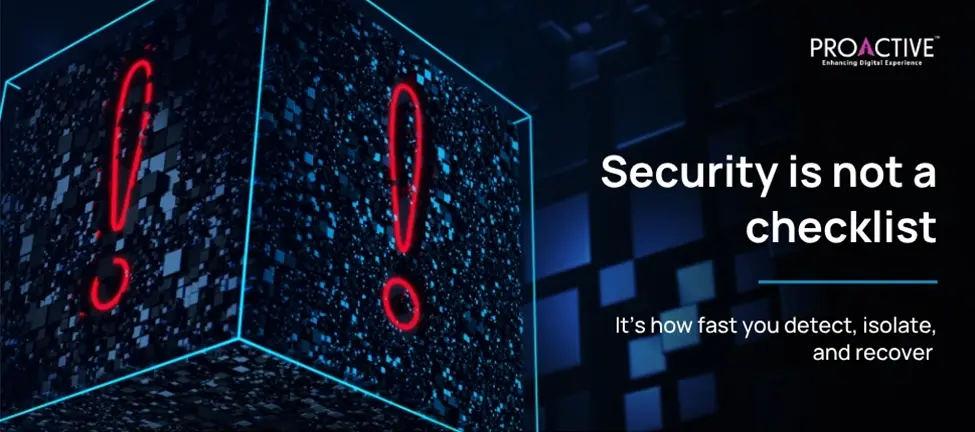Updated: July 28, 2025

What if your next breach doesn't come from malware but from a SaaS misconfiguration? What if it isn't your firewall that fails, but the policies around your OT network in Pune that no one reviewed in 18 months? These are not fringe cases. They reflect the emerging risks that large Indian enterprises now face daily.
For CIOs and CISOs in India, 2025 is not about buying more cybersecurity tools. It is about designing resilient security architectures that address the way work, data, and threats have evolved. Cybersecurity in Indian boardrooms has moved from compliance checklists to existential discussions on business continuity, regulatory risk, and operational downtime.
The distributed workforce, cloud-native apps, IIoT sensors in Bhiwadi, and cross-border SaaS tools have together dismantled the old security perimeter. If your enterprise still relies on perimeter-centric strategies, your exposure is growing by the day.
Zero Trust has become a critical safeguard mechanism. But moving from VPNs and access control lists to identity-based segmentation and adaptive access is a project in itself. Proactive Data Systems, unlike many Gold Partners, has built frameworks to phase this shift gradually across fragmented plants, branch offices, and supply chains. The key is not deployment, but orchestration.
In Bengaluru, one consumer goods giant replaced its fragmented security stack with a unified platform, integrating endpoint detection, identity verification, and network segmentation across its distributed offices. The result: not just improved protection, but fewer alerts and faster incident response.
If your developers in Gurugram are pushing new features every week, your security team cannot operate on quarterly review cycles. Indian enterprises, particularly in IT services and fintech, are now embedding security into DevOps pipelines. This shift-left approach reduces vulnerabilities before code even enters staging.
In manufacturing, where IT and OT now converge, the shift-left model is applied differently. Proactive recently worked with an automotive supplier to audit its IIoT protocols, segment its PLC traffic, and simulate fault injection scenarios. All before the new robotic assembly line went live.
Security breaches are moving downstream. As attackers exploit trusted vendor access, CISOs must now answer whether every supplier in their ERP network follows basic hygiene. According to Gartner, by 2025, 45 per cent of global organizations will experience a software supply chain attack, triple the number in 2021.
In India, with vast third-party ecosystems and legacy integration patterns, the risk multiplies. Enterprises are now auditing suppliers, enforcing identity federation standards, and restricting API calls using rate limiting and behavioural thresholds. A pharmaceutical major in Ahmedabad has made software bill of materials (SBOM) submission mandatory for all tech vendors.
No defence is perfect. The narrative among Indian CXOs has shifted to resilience. How quickly can your Hyderabad plant isolate a breach? Can you continue operations while recovering encrypted data? Does your SOC prioritise response over alert volume?
Leading firms now simulate attack scenarios with red-blue team drills. They are investing in automated containment, immutable backups, and SLA-driven incident response. Proactive's clients, across BFSI and manufacturing, report a 40 per cent reduction in MTTR (mean time to recover) when these practices are embedded.
Without observability, security is guesswork. Enterprises are now investing in XDR platforms that offer telemetry from endpoints, network traffic, SaaS usage, and cloud configurations. Data correlation is the difference between detecting a pattern and chasing alerts.
In Noida, a BPO company used Proactive's managed XDR service to detect lateral movement attempts across VLANs by combining DNS logs and identity access patterns. The attacker was inside for a little over 27 minutes. The breach was contained in 34.
Many enterprises in India own best-in-class security products but remain vulnerable. The issue is not tool shortage, but integration, oversight, and ownership. With increasing complexity, internal teams often lack the time, skills, or frameworks to orchestrate effective responses.
Proactive's approach aligns people, processes, and technology. It brings 24x7 managed detection, Cisco Duo for adaptive MFA, and granular visibility into OT and IT environments. Not in isolation, but as part of a service fabric built to respond in minutes, not hours.
Being breach-ready is not paranoia; it is preparation. Can your Hiranandani office isolate a compromised laptop within 5 minutes? Are your SaaS configurations audited weekly? Is your OT environment microsegmented?
Cybersecurity in 2025 is not a product line. It is an operational discipline. The enterprises that survive the next wave of attacks won't be those that bought the most tools. They will be the ones that responded fastest, planned recovery before detection, and never treated security as someone else's problem.
Proactive Data Systems delivers cybersecurity services that go beyond alerts and dashboards. With Cisco-backed platforms and domain expertise in manufacturing, IT/ITeS, and healthcare, we help enterprises reduce time to detect, contain, and recover. If your boardroom is asking bigger questions about security in 2025, it is time to speak with a partner that has bigger answers.